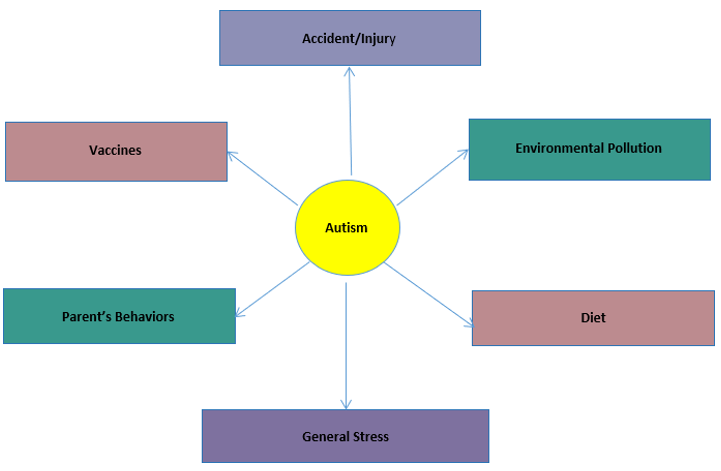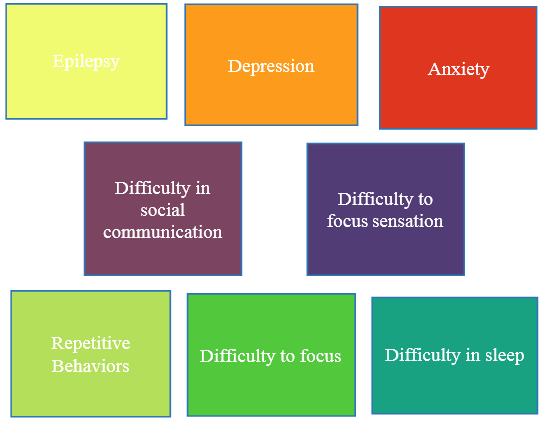Introduction
Autism spectrum disorder is a term used to describe a constellation of early-appearing social communication deficits and repetitive sensory–motor behaviour associated with a strong genetic component as well as other causes. The outlook for many individuals with autism spectrum disorder today is brighter than it was 50 years ago; more people with the condition are able to speak, read, and live in the community rather than in institutions, and some will be largely free from symptoms of the disorder by adulthood.1 Just under 1% of people globally are estimated to have autism, while estimates are higher in high-income nations. 2 Approximately 1 in 160 children worldwide are diagnosed with autism spectrum disorder, with a higher diagnosis rate among boys than girls.3 The phrase "Asperger's syndrome" is still occasionally used. In addition to epilepsy, melancholy, anxiety, and attention deficit hyperactivity disorder (ADHD), people with autism spectrum disorders frequently suffer from other illnesses.3 Families provide the majority of assistance for individuals with autism throughout their lifetime, helping them to become independent and lead better lives. 1, 2
What is Autism
Autism spectrum disorders, which include behavioral autism spectrum disorder, are a group of neurodevelopmental disorders that manifest as social communication and communication impairments, as well with stereotyping and repetitive behaviors.
Autism spectrum disorders are a group of developmental disorders diagnosed based on core behavioral symptoms, including problems with social interaction, abnormal communication skills, and atypically restricted, stereotyped, and repetitive behaviors.4 Children with autism have problems with social development and are interested in repetitive behavioral processes. ASD is often accompanied by intellectual disability and hyperactivity. In addition, children with ASD often have comorbidity such as abnormal sense of touch, food selectivity, and sleep disturbances. Currently, there is no unified theory that explains all core and concurrent abnormalities in children with ASD.5
What is Cardiac Rhythm
A circadian rhythm is a 24-hour pattern that is triggered by the body's internal biological clock. Human language, learning, memory, and social conduct all adjust to the sleep-wake cycles, and daily fluctuations are seen in all of these domains. As more and more human diseases, such as metabolic syndromes, cardiovascular disorders, diabetes, and cancer, have been related to circadian dysfunctions, the functional significance of the circadian clock is becoming clear. 4, 5, 6
An increasing body of research from basic and clinical investigations points to a possible connection between ASD and its pathophysiology and circadian timing system disruption. Finally, we suggest that an integrative approach to clinical treatments for individuals with ASD should take into account the dynamics of daily rhythms in physical, mental, and social processes. This would allow us to address ASD from a new angle by recognizing the functional significance of the circadian clock in both normal and aberrant neurodevelopmental processes. 4, 6
Strengths and Challenges Associated with Autism
Supports for the increasing number of college students with autism tend to be assistance-oriented. People with autism who are educated also face discrimination and other obstacles that can make it extremely difficult for them to find fulfilling employment. 4, 5, 6, 7
Many theories have been proposed to explain the ways in which strengths and challenges may coexist in populations of people with autism, especially in light of certain studies showing that, in comparison to their typically developing peers, young people on the autism spectrum may show superior local processing and poorer global processing of visual and auditory input. 8
Strengths-based research is scarce and primarily focuses on the caregivers of young adults with ASD rather than the young individuals themselves. It describes caregiver attributes that are predictive of favorable outcomes for the families of young adults with ASD. A modest body of research also highlights the promising early results of strength-framed education and skill development programs for young people, such as positively oriented problem-solving interventions and video self-modeling to boost confidence and success in daily chores. 9
Diagnosis of Autism
Autism spectrum disorder affects roughly 1 in 100 children globally. The median of cases of autism with mental retardation is 33.0%. 10
The mortality rate of children worldwide is between 60 and 100 per. The average for all countries combined is 83.2 child deaths per 10,000. There are only five countries in the world with higher autism rates. More than 100 children per 10,000, or more than 1%. 11
Autism Ratio as Per Gender
Girl shave a diagnosis of autism that is four times less common than that of boys. Recent studies have shown that for every two tot hree boys, one girl suffers from autism.11The median male-to-female ratio was 4:2.12At approximately age 2, a trained physician can diagnose autism, while Pervasive Development Disorder and Asperger's syndrome may not be recognized until later in life. Whether or not the subject was on the autism spectru m had a significant impact on the analysis. The ability of service systems to accuratel y determine who has autism.12. In the United Kingdom and the United States, diagnosis is made by a developmental pediatrician, psychologist, or psychiatrist using either the International Classification of Diseases Version 10,or the Diagnostic and Statistical Manual of Mental Disorders, 5th Edition (DSM-5). 12, 13
Assessment of developmental level of intellectual abilities
Cognitive dysfunction is nearly ubiquitous in ASD and important in determining overall functional capacity, although the severity and breadth of cognitive deficits vary widely in individuals on the spectrum. Additionally, it is important for the differential diagnosis or co-occurring diagnosis with mental retardation. 13, 14
Assessment of developmental level of language
Since 20–30% of people with ASD are nonverbal, a speech therapist evaluation is crucial.Early verbal communication is thought to be strongly predicted by a number of pre-verbal abilities, including cooperative attention, responding to speech, gestures, imitation, and symbolic play..14Children from the pediatric outpatient department were sequentially recruited if they showed signs of age inappropriate behavior, play, understanding, or social interaction, or if they showed abnormal language, delay or regression of developmental milestones.When a child presents with the same developmental disability, they may receive a different diagnosis later on. 15
Treatment
Educational and school-based therapies for autism
Children with autism are entitled to free, appropriate public education under federal law, sometimes known as "IDEA." IDEA guarantees that children with specific diagnoses, such as autism spectrum disorder (ASD), have access to educational materials and resources at no cost in order to optimize their learning potential. 16
Behavioral management therapy for autism
Behavior management therapy aims to increase desired behaviors while reducing undesirable ones. A variety of ABA techniques, including Positive Behavioral and Support (PBS), are widely used in the treatment of Autism Spectrum Disorder (ASD). PBS looks for the causes of a child's particular troublesome behavior. Behaviorally intensive treatment early on (EIBI). EIBI provides tailored behavioral instruction for infants with ASD. Discrete Trial Training (DTT) for instruction. DTT teaches skills in a controlled, systematic manner. 16
Nutritional therapy for autism
The nutrition required for healthy growth and development may not be provided to children diagnosed with autism spectrum disorder (ASD). At times, they might refrain from eating certain foods because they think they will cause them to feel uncomfortable or have stomach pain. 17
Gluten-free and casein-free diet (Table 1)
Table 1
Drug & source 18
Ketogenic diet
The body uses fat metabolism as its main fuel source when following the ketogenic diet (KD), which is low in carbohydrates, high in fat, and sufficiently high in protein. 19
Medication treatment for autism
Table 2
Drug & treatment 20
Social Skills Training for Autism
Social skills training teaches children the skills they need to interact with others.children improve several social skills:
Conversation
Handling teasing
Being a good sport 21
Speech-Language Therapy for Autism
Speech-language therapy can help people with autism spectrum disorder (ASD) improve their abilities to communicate and interact with others. 22
Parent-Mediated Therapy in Autism
This involves parents receiving professional therapy training so they can give their own children targeted therapies. Children who may be at-risk for autism but are too young for a diagnosis can also receive some therapies from their parents.
Physical Therapy for Autism
Strengthening, improving posture, balancing, and improving motor skills are all part of physical therapy. To help a child develop strength and muscle control, for instance, so that they can play more readily, is the goal of this kind of therapy.
Conclusion
Accessing individuals with ASD is a complex process that is affected by myriad variables. Evidence from the previous studies indicates that ASD is a new phenomenon that needs to be better understood. This study conducted a systematic literature review, explaining the ASD concept, presenting its sign, symptoms, diagnosis and treatment. At the individual level, ASD include calls for a stronger emphasis on measuring self-determination, quality of life & participation in decision making. Currently, the recent upward trend in rates of prevalence cannot be attributed directly to an increase in the incidence of the disorder or to an epidemic of autism. Although, power to detect time trends is seriously limited in existing data sets good evidence indicates that changes in diagnostic criteria and practices, policies for education services availability & awareness of ASDs in both the lay and the professional public may be responsible for increasing prevalence over time. It is difficult to determine the most effective treatment for ASD Because each therapy targets different symptoms. Therefore, many patients participate in at least one therapy in each intervention category. While it is common for patients to participate in multiple interventions like education and school based therapy, behavioral management therapy, nutritional therapy, medication therapy, parent mediated therapy. Unfortunately, the dietary options also cannot be compared because the dietary interventions used in those with ASD are based on the individual’s biology and what their digestive and metabolic systems require. It is unlikely that one dietary option will work for all ASD patients. Meanwhile, the available prevalence figures carry straightforward implication for current and future needs in services and early educational intervention programs.



